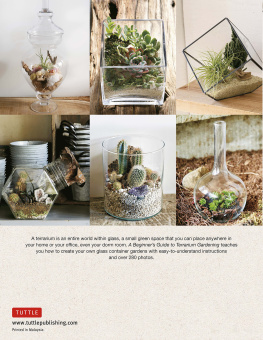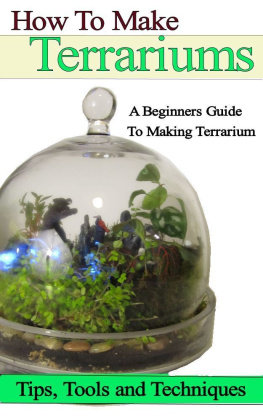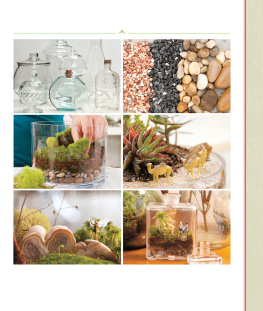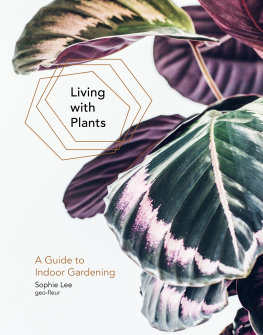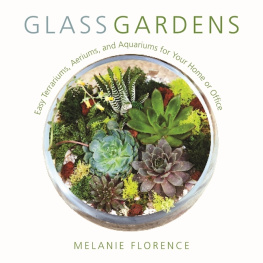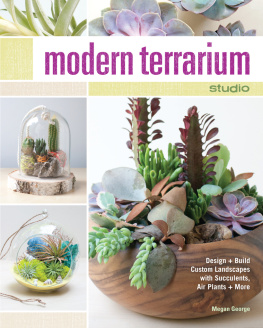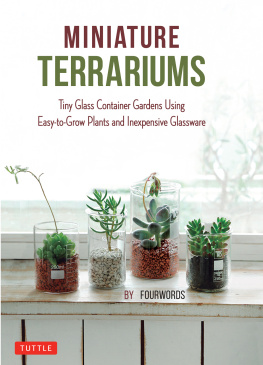Thank you for purchasing this Martha Pullen eBook.
Sign up for our newsletter and receive special offers, access to free content, and information on the latest new releases and must-have crafting resources! Plus, receive a coupon code to use on your first purchase from Store.MarthaPullen.com for signing up.
or visit us online to sign up at
http://marthapullen.com/ebook-promo
For my beloved Nana a woman worth remembering.
Contents
Introduction
I grew up in a home filled with greenery. One of my earliest childhood memories is of the large glass terrarium that sat proudly in the corner of the foyer at my Nanas home in southern North Carolina. It was a floor model, standing over five feet tall (1.5m), full of lush houseplants that quietly crept up its enclosure walls over the years. The terrarium, made by my mother and father in the mid-1980s shortly before they married, is shaped similarly to a groovy 1970s lava lamp. I was drawn to that terrarium, always pressing my nose and hands against the glass, curious to explore the beautiful landscape insidesomething I do even now, more than twenty years later.
When I opened my modern terrarium and craft business, The ZEN Succulent, the first piece I created was a succulent terrarium; I gravitated to the unique textures, shapes and colors of these particular plants. This was the beginning of my succulent obsession, an obsession that now includes tillandsia air plants and living landscapes.
Terrariums have become popular in recent years, but their history dates back as early as the nineteenth century. After having trouble maintaining healthy ferns outdoors in the polluted London air, Dr. Nathaniel Ward noticed that a tiny fern and grass seed had sprouted in the damp soil contained in a covered jar that also held a cocoon he had been studying. As he continued to observe this unintended occurrence, he noticed that evaporated moisture from the soil condensed on the glass during the day and ran down and back into the soil in the evening, creating a humid, self-contained environment. Dr. Ward published works on his discovery of these miniature greenhouses, later called the Wardian cases, which were early versions of the modern terrarium.
Modern Terrarium Studio was written with the goal of learning more about the world of succulents and air plants through projects that explore different terrarium designs. The first part of the book focuses on what you need to start your succulent and air plant terrariums, gives basic instructions on how to maintain your plants health and discusses key elements of terrarium design that will make yours unique. The second part provides step-by-step instructions for creating your own terrariums perfect for everyday decorating and presents clever ways to incorporate living landscapes into your special occasion dcor.
While writing this book, I spent countless hours creating and expanding my succulent and air plant knowledge. Taking time to just create and perfect my craft was beautiful and calming. I hope that the living landscapes in this book help you find peace as well. With each project, your confidence will grow, youll develop your own preferences and techniques, and eventually you will master each design, elevating them with your own personality and aesthetic.
Happy making,
Cheers!

Getting Started
THIS CHAPTER IS FILLED with my personal advice for terrarium creation, gleaned from years of working successfully with succulents and air plants. Well go over the basic foundation for each terrarium, how to choose the right plants for any landscape, which containers are best and how to use simple accents to great effect.
The information in this chapter will become a point of reference when questions arise about plant care and design. As you create and care for your own terrariums and landscapes, you too will develop your own tips and pointers based on your own experiences with each plant; have fun learning from it.

Tools + Materials
The tools listed here are useful when creating or caring for the terrariums and living landscapes mentioned in this book. A few specific tools may be needed for individual projects; those tools are discussed within the projects themselves.
| TOOL | USE |
|---|
| E6000 glue (1) | Plant-safe glue used to attach air plants and other materials to a variety of surfaces; choose clear glue for an invisible finish |
| Embroidery floss (2) | Hang, attach and tie plant materials safely together; also can be used as a colored accent. |
| Floral wire (3) | Secure air plants to wood or other plants. |
| Gardening gloves | Protect hands during planting. |
| Hammer (4) | Hang terrariums and add decorative nails. |
| Mini tubing cutter (5) | Cut brass rods for himelli planters |
| Newspaper | Protects work surfaces and can be used to handle cacti. |
| Paintbrushes (6) | Brush dirt off plants and for other general cleanup. |
| Pencil | Good to mark material placement when designing living landscapes. |
| Pruning shears | Cut back succulent roots, remove damaged or withered leaves, and collect cuttings from overgrown plants; cut wood for arrangements. |
| Scissors (7) | Cut floss and shape preserved reindeer moss and moss materials; can use to trim plants as well. |
| Spray bottle (8) | Mist the plants as needed between watering; can be used to water air plants. |
| Tweezers | Place pebbles, seashells, wood or any other accent materials into the tight spaces that a wooden dowel might not reach. |
| Watering can | Cans with long, narrow spouts work best for precise watering of container arrangements. |
| Wire cutters | Cut floral wire. |
| Wooden dowel (9) | Position plants for planting as well as any other small materials during terrarium creation. |

Basic Layering Materials
SUCCULENT AND PLANT TERRARIUMS
When making a succulent and plant terrarium, the basic layering materials provide the foundation for the entire living landscape. Without these simple ingredients, the terrarium will not have what it needs to grow and flourish for years to come.
These are the layers, in order of how they should be assembled:


